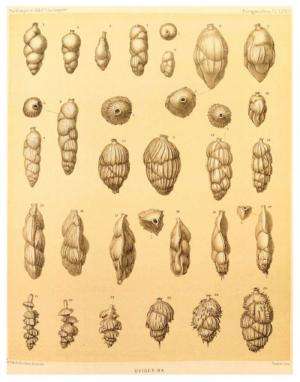Deep ocean sediment gives ancient temperature record

Scientists have created a more accurate history of how Earth's climate has varied over the last 1.5 million years, after developing a new method that lets them draw on natural temperature records that have never before been analysed.
The new technique means they can get round the deficiencies of earlier ways of working out what the ancient climate was like. These are distorted by measuring both the Earth's temperature and the amount of its water locked up in glaciers and icecaps. For the first time, the new technique allows scientists to disentangle the two effects, giving a much more detailed view of how the climate has fluctuated between warm and cold periods.
The study also sheds new light on an important turning-point in climate history, known as the Mid-Pleistocene Transition (MPT) - a major shift that took place between 1.25 million and 600,000 years ago, when the planet's ice ages moved from a 40,000-year cycle to a 100,000-year one due to small, recurrent changes in its orbit around the Sun.
'Previously we didn't really know what happened during this transition, or on either side of it,' explains Professor Harry Elderfield of the University of Cambridge, who led the study. 'Before you separate the ice volume and temperature signals, you don't know whether you're seeing a climate record in which ice volume changed dramatically, the oceans warmed or cooled substantially, or both. Now, for the first time we have been able to separate these two components, which means that we stand a much better chance of understanding the mechanisms involved.'
The new technique works by analysing variations in the ratio of magnesium to calcium contained in the fossilised shells of tiny microorganisms called foraminifera trapped in successive layers of sediment on the seabed. As the foraminifera were growing, they absorbed calcium and magnesium in proportions that depended on the temperature of the water around them.
Previous methods instead used the ratio between two forms of oxygen, known as isotopes - one slightly heavier than the other. Oxygen isotope analysis was originally conceived as a proxy for past temperatures. But later scientists pointed out that the ratio was more heavily influenced by how much ice there was at the time the foraminifera were alive than by the temperature per se - more of the lighter isotope tends to get locked up in ice as it formed, so the water left in the oceans has more of the heavier one, and foraminifera shells preserve this difference. So in recent years scientists have seen oxygen isotopes as an indicator of the total volume of ice on Earth, ignoring the temperature component.
The study, which appears in Science, was carried out over several years by Elderfield and colleagues in the Cambridge Earth Sciences department. They believed the prevailing view was wrong - that temperature does affect the results of oxygen isotope analysis. But to find out how large its role is, they needed a way to disentangle the influence of ice from that of temperature. They realised that the magnesium/calcium ratio would let them do this, as it depends only on temperature and not on ice.
Once they'd chosen a suitable site where the Integrated Ocean Drilling Programme - an international project to recover seabed sediment samples from deep-water locations all over the world - had already extracted a sediment core deposited over the past 1.5 million years that contained the right kind of foraminifera, they secured access to part of that core and painstakingly took samples along its length.
They then washed away the mud from each sample, picked out the particular kind of fossil foraminifera they were interested in, cleaned them and fed them into a mass spectrometer, which measured the relative quantities of magnesium and calcium.
The colder the water, the less magnesium the foraminifera absorb and build into their shells. So by analysing the ratio between the two elements at depth intervals, each equivalent to around a few hundred years, throughout the length of the core, they could get an accurate record of the deep ocean temperature at this location over the past 1.5 million years. By subtracting these results from those of oxygen isotope analysis of the same core, they could also arrive at a record of how much ice was on the planet over the same period.
Elderfield and his colleagues are now planning to use their technique on cores drilled from different parts of the seabed; they say the location this study was based on, near the Chatham Rise off New Zealand, provides a good representation of the water of at least half the world's deep ocean, but acknowledge that looking at more sites will help complete the picture - ultimately this could help understand the complex effect that the long cycles of the Earth's orbit have on its climate.
In the long term, they hope that understanding past changes in the climate will help us predict future change more effectively, including the contribution of human activities including carbon dioxide emissions. 'If we can understand how earlier changes were initiated and what the impacts were, we stand a much better chance of being able to predict and prepare for changes in the future,' Elderfield says.
More information: Evolution of Ocean Temperature and Ice Volume Through the Mid-Pleistocene Climate Transition. H Elderfield, P Ferretti, M Greaves, S Crowhurst, IN McCave, D Hodell, AM Piotrowski. Science 10 August 2012: Vol. 337 no. 6095 pp. 704-709. DOI: 10.1126/science.1221294
Journal information: Science
Provided by PlanetEarth Online
This story is republished courtesy of Planet Earth online, a free, companion website to the award-winning magazine Planet Earth published and funded by the Natural Environment Research Council (NERC).















